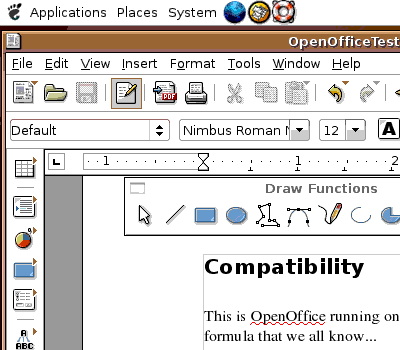May 20th, 2005
The Becta report based on an ‘oportunity’ sample of schools using Open Source software to varying extents compared to schools using commercial software (i.e. Windows servers, desktops and Office) has now been published (publication was delayed during the General Election).
There is a lot of interesting stuff in the report – not least the authors’ examination of the equilibrium between staff training and direct support costs in the various schools. Open Source software was being used in three categories; server, desktop OS and applications. Applications included
- OpenOffice (and Star Office)
- The GIMP graphics program (both for painting and for photo retouching interestingly)
- Audacity sound editor
and other bits and pieces. The anecdote that stuck in my mind most was the classroom support assistant who sometimes used MS Word (Word Art for posters) and sometimes used OpenOffice (for ‘bashing in lots of text’) and saw them simply as slightly different tools for different jobs.
There is a lot in this report of interest apart from the Open Source angle – just views of teachers and support staff about the use of IT in education, and the way that the introduction of new technology can increase support/training issues in a cycle. A full summary will appear soon!
Posted in ILT, Notes | Comments Off
May 19th, 2005
The Google data center is not filled with super expensive high tech brand name gear such as Sun, Dell, or Microsoft Exchange. Instead, Google has a large farm of sleek and stripped PCs with the motherboards circuit screwed onto a plain metal slab, with each hard drive attached to the contraptions by a plain old Velcro strap. There are 15000 Google computers, as described above, in the Google farm. The Google farm of computers is growing at the rate of 1500 new machines a month. These super fast machines have RAM in the gigabytes, spanking fast hard drives, and they are running Linux—one of the best and fastest free operating systems. Eric Wolfram, Score Higher in Google Search Engine
One example I used in the Forensic ICT module was a ‘link spammed’ WordPress 1.2 install. Link spamming us an attempt by a commercial site increase the number of pages that link to the site – thus raising the Google score for the site even though the site (a casino in the case of the WordPress link spam) has nothing to do with the contents of the spammed page.
This raised the issue of how Google works, and Eric Wolfram’s page about how Google works has some fascinating facts and insights. He links Google ranking with good Web design and meaningful markup. Wolfram’s page is argumentative in nature and he is making a case for external links. Web Design students might want to ask themselves if they agree with Wolfram’s ideas as a way of focussing their own thoughts.
Webcoder also has some information on recent Google patents
Posted in Web | Comments Off
May 18th, 2005

Using the Ubuntu Linux 5.04 release on a live CD on my iBook (the old Windows laptop won’t boot from CD-ROM) results in a slow enough boot up to show how a linux boot works. The ‘live’ CD does not touch the iBook hard drive, so a ramdisk is set up, and then Linux is installed in the ramdisk.
- Gnome desktop
- Logical menus with easy access to OpenOffice
- Live CD does not detect iBook modem and won’t access the hard drive
- USB pen drive works fine
- OpenOffice 1.1.3 (last version)
- Firefox 1.0.2 (last version)
- Evolution looks quite a nice e-mail package with integrated calendar and todos
If you had an old G3 iMac or Intel box (and plenty of RAM) then a single CD Ubuntu install might be all you need.
The Mac OS X Disk Utility won’t burn Ubuntu iso images for some strange reason – I found MissingMediaBurner (a graphical front end to the command line cdrecord utility) worked fine.
Posted in Ubuntu | Comments Off
May 17th, 2005
When a group at Apple Computer studied piling behavior several years ago, they found that even the most disorderly pile usually make perfect sense to the piler, and that office workers could hold forth in great detail about the precise history and meaning of their piles. Malcolm Gladwell, The Social Life of Paper , New York Times, March 18th, 2002.
It turns out that paper may have many ‘affordances’ that make it useful in negotiation and collaborative activities. Turn the coin over, and ILT in the classroom – and specifically the use of computer aided learning materials where students interact directly with the screen – may have value in focussing students onto certain ideas and concepts for short periods.
I’ll be exploring that one soon. See also…
Posted in ILT | Comments Off
May 16th, 2005
The A series of paper sizes (and the B series come to that) have the property that when you fold a sheet in half with the fold parallel to the short side, the ratio of the sides remains the same. This means that the sides must be in the ratio 1:1.414. The algebra is sketched below (on a 5 by 3 inch record card scanned at 75 dpi).

This is one of the most accessible situations I know of where a quadratic equation (a very simple one) can be set up and solved.
Posted in Maths, Notes | Comments Off
May 15th, 2005
Survey! Question! Read! Recite! Review! is a reading framework that is suggested for University students.
As I find myself teaching a reading / writing based subject (Forensic ICT) to a group of sixth formers and some adults in the evening, I come up against problems with reading, summarising and writing. I have been ‘scaffolding’ complex readings with a set of questions that students answer (Moodle ‘Journal’ items for next year – just starting to use Moodle for an adult class now).
The next phase for the sixthformers is to get them to write their own scaffold, perhaps using the SQR3 method themselves. Might work, only one way to find out!
The same Web site has some stuff on time management and study motivation – I think I’ll leave that one for the universities! One local university has a large Moodle project in flow and some staff are finding the time management aspects of online study useful with students.
Posted in Forensic, Notes | Comments Off
May 15th, 2005


Olympus digicam on ‘macro’.
Posted in Photos | Comments Off



